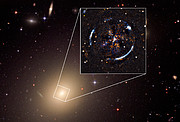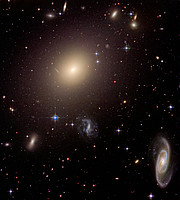Press Release
VLT Makes Most Precise Test of Einstein’s General Relativity Outside Milky Way
21 June 2018
Astronomers using the MUSE instrument on ESO’s Very Large Telescope in Chile, and the NASA/ESA Hubble Space Telescope, have made the most precise test yet of Einstein’s general theory of relativity outside the Milky Way. The nearby galaxy ESO 325-G004 acts as a strong gravitational lens, distorting light from a distant galaxy behind it to create an Einstein ring around its centre. By comparing the mass of ESO 325-G004 with the curvature of space around it, the astronomers found that gravity on these astronomical length-scales behaves as predicted by general relativity. This rules out some alternative theories of gravity.
Using the MUSE instrument on ESO’s VLT, a team led by Thomas Collett from the University of Portsmouth in the UK first calculated the mass of ESO 325-G004 by measuring the movement of stars within this nearby elliptical galaxy.
Collett explains “We used data from the Very Large Telescope in Chile to measure how fast the stars were moving in ESO 325-G004 — this allowed us to infer how much mass there must be in the galaxy to hold these stars in orbit.”
But the team was also able to measure another aspect of gravity. Using the NASA/ESA Hubble Space Telescope, they observed an Einstein ring resulting from light from a distant galaxy being distorted by the intervening ESO 325-G004. Observing the ring allowed the astronomers to measure how light, and therefore spacetime, is being distorted by the huge mass of ESO 325-G004.
Einstein’s general theory of relativity predicts that objects deform spacetime around them, causing any light that passes by to be deflected. This results in a phenomenon known as gravitational lensing. This effect is only noticeable for very massive objects. A few hundred strong gravitational lenses are known, but most are too distant to precisely measure their mass. However, the galaxy ESO 325-G004 is one of the closest lenses, at just 450 million light-years from Earth.
Collett continues “We know the mass of the foreground galaxy from MUSE and we measured the amount of gravitational lensing we see from Hubble. We then compared these two ways to measure the strength of gravity — and the result was just what general relativity predicts, with an uncertainty of only 9 percent. This is the most precise test of general relativity outside the Milky Way to date. And this using just one galaxy!”
General relativity has been tested with exquisite accuracy on Solar System scales, and the motions of stars around the black hole at the centre of the Milky Way are under detailed study, but previously there had been no precise tests on larger astronomical scales. Testing the long range properties of gravity is vital to validate our current cosmological model.
These findings may have important implications for models of gravity alternative to general relativity. These alternative theories predict that the effects of gravity on the curvature of spacetime are “scale dependent”. This means that gravity should behave differently across astronomical length-scales from the way it behaves on the smaller scales of the Solar System. Collett and his team found that this is unlikely to be true unless these differences only occur on length scales larger than 6000 light-years.
“The Universe is an amazing place providing such lenses which we can use as our laboratories,” adds team member Bob Nichol, from the University of Portsmouth. “It is so satisfying to use the best telescopes in the world to challenge Einstein, only to find out how right he was.”
More information
This research was presented in a paper entitled “A precise extragalactic test of General Relativity” by Collett et al., to appear in the journal Science.
The team is composed of T. E. Collett (Institute of Cosmology and Gravitation, University of Portsmouth, Portsmouth, UK), L. J. Oldham (Institute of Astronomy, University of Cambridge, Cambridge, UK), R. Smith (Centre for Extragalactic Astronomy, Durham University, Durham, UK), M. W. Auger (Institute of Astronomy, University of Cambridge, Cambridge, UK), K. B. Westfall (Institute of Cosmology and Gravitation, University of Portsmouth, Portsmouth, UK; University of California Observatories – Lick Observatory, Santa Cruz, USA), D. Bacon (Institute of Cosmology and Gravitation, University of Portsmouth, Portsmouth, UK), R. C. Nichol (Institute of Cosmology and Gravitation, University of Portsmouth, Portsmouth, UK), K. L. Masters (Institute of Cosmology and Gravitation, University of Portsmouth, Portsmouth, UK), K. Koyama (Institute of Cosmology and Gravitation, University of Portsmouth, Portsmouth, UK), R. van den Bosch (Max Planck Institute for Astronomy, Königstuhl, Heidelberg, Germany).
ESO is the foremost intergovernmental astronomy organisation in Europe and the world’s most productive ground-based astronomical observatory by far. It has 15 Member States: Austria, Belgium, Czechia, Denmark, France, Finland, Germany, Italy, the Netherlands, Poland, Portugal, Spain, Sweden, Switzerland and the United Kingdom, along with the host state of Chile and with Australia as a strategic partner. ESO carries out an ambitious programme focused on the design, construction and operation of powerful ground-based observing facilities enabling astronomers to make important scientific discoveries. ESO also plays a leading role in promoting and organising cooperation in astronomical research. ESO operates three unique world-class observing sites in Chile: La Silla, Paranal and Chajnantor. At Paranal, ESO operates the Very Large Telescope and its world-leading Very Large Telescope Interferometer as well as two survey telescopes, VISTA working in the infrared and the visible-light VLT Survey Telescope. ESO is also a major partner in two facilities on Chajnantor, APEX and ALMA, the largest astronomical project in existence. And on Cerro Armazones, close to Paranal, ESO is building the 39-metre Extremely Large Telescope, the ELT, which will become “the world’s biggest eye on the sky”.
Links
- Research paper
- ESA/Hubble release
- Photos of the VLT
- Information about the MUSE instrument on the VLT
Contacts
Thomas Collett
Institute of Cosmology and Gravitation — University of Portsmouth
Portsmouth, UK
Tel: +44 239 284 5146
Email: thomas.collett@port.ac.uk
Richard Hook
ESO Public Information Officer
Garching bei München, Germany
Tel: +49 89 3200 6655
Cell: +49 151 1537 3591
Email: pio@eso.org
About the Release
| Release No.: | eso1819 |
| Name: | ESO 325-G004 |
| Type: | Early Universe : Cosmology |
| Facility: | Very Large Telescope |
| Instruments: | MUSE |
| Science data: | 2018Sci...360.1342C |








